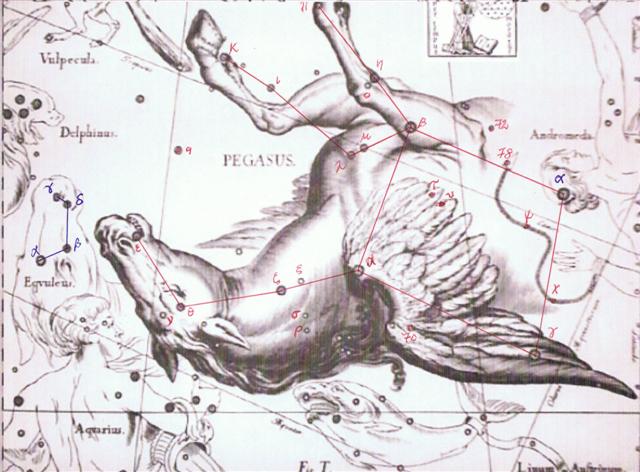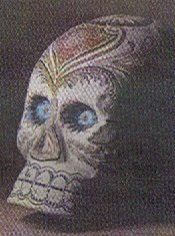Although seemingly insignificant the Foal was one of Ptolemy's 48 constellations. The Babylonians, though, had another version of the concept of the released 'Fire' (Sun):  The Horse (below the Milky Way) is face to face with the Stag (body drawn inside the Milky Way) and Field (the Pegasus Square) is connected with the Horse. Horse is reversed compared to the orientation of most other figures in the zodiac and this Sign ought to mean it represents the end of a cycle. Stag will then surely represent the beginning of next cycle. The 'Fire' generated from its antlers will result in a separation from the rainy season, this we can understand from Rainbow in contact with Stag. Field represents the season before Rainbow, which explains why there are wave signs inside its rectangular outline. From this it can be concluded that both Pegasus and Foal belong close to the end of the old cycle. Even the head of Andromeda is evidently belonging in the last part of the old cycle:  The Foal is nothing but a head (maybe his body is in the Milky Way). But in contrast to the head of Andromeda the head of the Foal belongs in the first part of the new cycle. Although Foal today comes earlier than Pegasus the whole constellation pair must at some time been turned upside down, resulting in the Foal (alias the Stag) coming earlier than Pegasus:  One in the first pair of Pegasus stars has the Greek letter κ - viz. Jih ('Sun') - which implies a reversal in time. This should be the result of turning the picture 180º around.
I have earlier suggested ε was used for the first star in a constellation and κ for the last star - like the idea of alpha in contrast to omega. Here it therefore could express something similar, viz. how the beginning (ε) is close to the end (κ) of a cycle. In order not to leave a gap a new beginning should come a little earlier than the old ending. Hevelius has avoided ε Equulei in his drawing. Perhaps he thought it rose too early for the idea of 21h as a border from where the 'Red Head' would develop. In the Hindu star list the first station is connected with a horse's head:
But the time is defined from β and γ Arietis (Sheratan and Mesarthim), which in rongorongo times rose heliacally around 392 days from March 21:
The Horse's Head evidently could refer to the beginning of counting to a new 'Man' (tagata) and it would be strange if not Polaris was the real such 'head', representing the new cycle instead of the old 'pillar of exit':
From Kitalpha to Polaris there are 26.6 + 365¼ - 322.0 = ca 70 days. 472 - 70 = 402 and measuring a cycle as around 400 nights instead of around 365 days could mean the Horse's Red Head had to be at the beginning of February instead of in April 16 (107):
A 'nut' is growing in the day after Kitalpha, in day 260 counted from the beginning of the G text (from Gb8-30). This 'nut' can be compared with that in Ca1-26. The pair of henua glyphs in February 6 and February 8 were probably drawn in order to put the focus of interest on February 7 (2-7). They have dots and in Gb2-5 (at the last Foal star) the bottom end of henua is drawn straight, perhaps to indicate where growth has begun, the growth of the lucky season arriving after the rains have been keeping sky and earth 'in close embrace'.
| ||||||||||||||||||||||||||||||||||||||||||||||||||||||||||||||||||||||||||||||||||||||||||||||||||||||||||||||||||||||||||||||||||||||||||||||||||||||||||||||||||||||||||||






